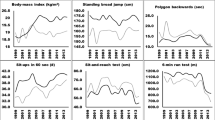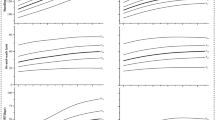Abstract
Objective:
To examine the reliability of a set of health-related physical fitness tests used in the European Union-funded Healthy Lifestyle in Europe by Nutrition in Adolescence (HELENA) Study on lifestyle and nutrition among adolescents.
Design:
A set of physical fitness tests was performed twice in a study sample, 2 weeks apart, by the same researchers.
Participants:
A total of 123 adolescents (69 males and 54 females, aged 13.6±0.8 years) from 10 European cities participated in the study.
Measurements:
Flexibility, muscular fitness, speed/agility and aerobic capacity were tested using the back-saver sit and reach, handgrip, standing broad jump, Bosco jumps (squat jump, counter movement jump and Abalakov jump), bent arm hang, 4 × 10 m shuttle run, and 20-m shuttle run tests.
Results:
The ANOVA analysis showed that neither systematic bias nor sex differences were found for any of the studied tests, except for the back-saver sit and reach test, in which a borderline significant sex difference was observed (P=0.044). The Bland–Altman plots graphically showed the reliability patterns, in terms of systematic errors (bias) and random error (95% limits of agreement), of the physical fitness tests studied. The observed systematic error for all the fitness assessment tests was nearly 0.
Conclusions:
Neither a learning nor a fatigue effect was found for any of the physical fitness tests when repeated. The results also suggest that reliability did not differ between male and female adolescents. Collectively, it can be stated that the reliability of the set of physical fitness tests examined in this study is acceptable. The data provided contribute to a better understanding of physical fitness assessment in young people.
This is a preview of subscription content, access via your institution
Access options
Subscribe to this journal
Receive 12 print issues and online access
$259.00 per year
only $21.58 per issue
Buy this article
- Purchase on Springer Link
- Instant access to full article PDF
Prices may be subject to local taxes which are calculated during checkout



Similar content being viewed by others
References
Myers J, Prakash M, Froelicher V, Do D, Partington S, Atwood JE . Exercise capacity and mortality among men referred for exercise testing. N Engl J Med 2002; 346: 793–801.
Gulati M, Pandey DK, Arnsdorf MF, Lauderdale DS, Thisted RA, Wicklund RH et al. Exercise capacity and the risk of death in women: the St James Women Take Heart Project. Circulation 2003; 108: 1554–1559.
Carnethon MR, Gulati M, Greenland P . Prevalence and cardiovascular disease correlates of low cardiorespiratory fitness in adolescents and adults. JAMA 2005; 294: 2981–2988.
Andersen LB, Harro M, Sardinha LB, Froberg K, Ekelund U, Brage S et al. Physical activity and clustered cardiovascular risk in children: a cross-sectional study (The European Youth Heart Study). Lancet 2006; 368: 299–304.
Moreno LA, González-Gross M, Kersting M, Molnár D, de Henauw S, Beghin L et al. Healthy lifestyle in Europe by nutrition in adolescence. The HELENA Study. Public Health Nutr 2008; 11: 288–299.
Ruiz JR, Ortega FB, Gutierrez A, Meusel D, Sjöström M, Castillo MJ . Health-related fitness assessment in childhood and adolescence: a European approach based on the AVENA, EYHS and HELENA studies. J Public Health 2006; 14: 269–277.
Atkinson G, Nevill AM . Statistical methods for assessing measurement error (reliability) in variables relevant to sports medicine. Sports Med 1998; 26: 217–238.
Rothwell PM . Analysis of agreement between measurements of continuous variables: general principles and lessons from studies of imaging of carotid stenosis. J Neurol 2000; 247: 825–834.
Bruton A, Conway JH, Holgate ST . Reliability: what is it, and how is it measured? Physiotherapy 2000; 86: 94–99.
Li AM, Yin J, Yu CC, Tsang T, So HK, Wong E et al. The six-minute walk test in healthy children: reliability and validity. Eur Respir J 2005; 25: 1057–1060.
Ruiz JR, Espana-Romero V, Ortega FB, Sjostrom M, Castillo MJ, Gutierrez A . Hand span influences optimal grip span in male and female teenagers. J Hand Surg [Am] 2006; 31: 1367–1372.
Leger LA, Mercier D, Gadoury C, Lambert J . The multistage 20 metre shuttle run test for aerobic fitness. J Sports Sci 1988; 6: 93–101.
Altman DG, Bland JM . Measurement in medicine: the analysis of method comparison studies. Statistician 1983; 32: 307–317.
Bland JM, Altman DG . Statistical methods for assessing agreement between two methods of clinical measurement. Lancet 1986; 1: 307–310.
Erbaugh SJ . Reliability of physical fitness tests administered to young children. Percept Mot Skills 1990; 71: 1123–1128.
Cotten DJ . An analysis of the NCYFS II Modified Pull-up Test. Res Q Exerc Sport 1990; 61: 272–274.
Atwater SW, Crowe TK, Deitz JC, Richardson PK . Interrater and test-retest reliability of two pediatric balance tests. Phys Ther 1990; 70: 79–87.
Engelman ME, Morrow Jr JR . Reliability and skinfold correlates for traditional and modified pull-ups in children grades 3–5. Res Q Exerc Sport 1991; 62: 88–91.
Kollath JA, Safrit MJ, Zhu W, Gao LG . Measurement errors in modified pull-ups testing. Res Q Exerc Sport 1991; 62: 432–435.
Rikli RE, Petray C, Baumgartner TA . The reliability of distance run tests for children in grades K-4. Res Q Exerc Sport 1992; 63: 270–276.
Liu NY, Plowman SA, Looney MA . The reliability and validity of the 20-meter shuttle test in American students 12–15 years old. Res Q Exerc Sport 1992; 63: 360–365.
Pate RR, Burgess ML, Woods JA, Ross JG, Baumgartner T . Validity of field tests of upper body muscular strength. Res Q Exerc Sport 1993; 64: 17–24.
McManis BG, Wuest DA . Stability reliability of the modified push-up in children. Res Q Exerc Sport 1994; 65 (Suppl): A58–A59 (abstract).
Patterson P, Wiksten DL, Ray L, Flanders C, Sanphy D . The validity and reliability of the back saver sit-and-reach test in middle school girls and boys. Res Q Exerc Sport 1996; 67: 448–451.
Mahar MT, Rowe DA, Parker CR, Mahar FJ, Dawson DM, Holt JE . Criterion-referenced and norm-referenced agreement between the mile run/walk and PACER. Meas Phys Educ Exerc Sci 1997; 1: 245–258.
Anderson EA, Zhang JJ, Rudisill ME, Gaa J . Validity and reliability of a timed curl-up test: development of a parallel form for the FITNESSGRAM abdominal strength test. Res Q Exerc Sport 1997; 68 (Suppl): A-51.
Patterson P, Rethwisch N, Wiksten D . Reliability of the trunk lift in high school boys and girls. Meas Phys Educ Exerc Sci 1997; 1: 145–151.
McSwegin PJ, Plowman SA, Wolff GM, Guttenberg GL . The validity of a one-mile walk test for high school age individuals. Meas Phys Educ Exerc Sci 1998; 2: 47–63.
McManis BG, Baumgartner TA, West DA . Objectivity and reliability of the 90° pushup test. Meas Phys Educ Exerc Sci 2000; 4: 57–67.
Figueroa-Colon R, Hunter GR, Mayo MS, Aldridge RA, Goran MI, Weinsier RL . Reliability of treadmill measures and criteria to determine VO2max in prepubertal girls. Med Sci Sports Exerc 2000; 32: 865–869.
Patterson P, Bennington J, De La Rosa T . Psychometric properties of child- and teacher-reported curl-up scores in children aged 10–12 years. Res Q Exerc Sport 2001; 72: 117–124.
Tong TK, Fu FH, Chow BC . Reliability of a 5-min running field test and its accuracy in VO2max evaluation. J Sports Med Phys Fitness 2001; 41: 318–323.
Romain BS, Mahar MT . Norm-referenced and criterion-referenced reliability of the push-up and modified pull-up. Meas Phys Educ Exerc Sci 2001; 5: 67–80.
Alricsson M, Harms-Ringdahl K, Werner S . Reliability of sports related functional tests with emphasis on speed and agility in young athletes. Scand J Med Sci Sports 2001; 11: 229–232.
Johnston KN, Jenkins SC, Stick SM . Repeatability of peak oxygen uptake in children who are healthy. Pediatr Phys Ther 2005; 17: 11–17.
de Greef MH, Sprenger SR, Elzenga CT, Popkema DY, Bennekers JH, Niemeijer MG et al. Reliability and validity of a twelve-minute walking test for coronary heart disease patients. Percept Mot Skills 2005; 100: 567–575.
Taylor S, Frost H, Taylor A, Barker K . Reliability and responsiveness of the shuttle walking test in patients with chronic low back pain. Physiother Res Int 2001; 6: 170–178.
Buckley JP, Sim J, Eston RG, Hession R, Fox R . Reliability and validity of measures taken during the Chester step test to predict aerobic power and to prescribe aerobic exercise. Br J Sports Med 2004; 38: 197–205.
Bingisser R, Kaplan V, Scherer T, Russi EW, Bloch KE . Effect of training on repeatability of cardiopulmonary exercise performance in normal men and women. Med Sci Sports Exerc 1997; 29: 1499–1504.
Lamb KL, Eston RG, Corns D . Reliability of ratings of perceived exertion during progressive treadmill exercise. Br J Sports Med 1999; 33: 336–339.
van ′t Hul A, Gosselink R, Kwakkel G . Constant-load cycle endurance performance: test-retest reliability and validity in patients with COPD. J Cardiopulm Rehabil 2003; 23: 143–150.
Balfour-Lynn IM, Prasad SA, Laverty A, Whitehead BF, Dinwiddie R . A step in the right direction: assessing exercise tolerance in cystic fibrosis. Pediatr Pulmonol 1998; 25: 278–284.
Wallman K, Goodman C, Morton A, Grove R, Dawson B . Test-retest reliability of the aerobic power index component of the tri-level fitness profile in a sedentary population. J Sci Med Sport 2003; 6: 443–454.
Ruiz JR, Ortega FB, Meusel D, Harro M, Oja P, Sjöström M . Cardiorespiratory fitness is associated with features of metabolic risk factors in children. Should cardiorespiratory fitness be assessed in a European health monitoring system? The European Youth Heart Study. J Public Health 2006; 14: 94–102.
Bland JM, Altman DG . Measuring agreement in method comparison studies. Stat Methods Med Res 1999; 8: 135–160.
Acknowledgements
The HELENA Study was carried out with the financial support of the European Community Sixth RTD Framework Programme (Contract FOOD-CT-2005-007034). It is also being supported by grants from CSD in Spain (109/UPB31/03 and 13/UPB20/04), the Spanish Ministry of Education (EX-2007-1124; AP-2004-2745; AP2005-4358) and the ALPHA study, a European Union-funded study, in the framework of the Public Health Programme (Ref: 2006120). The researchers from the University of Zaragoza, Spain (GVR, JPRL) are complementarily supported by FUNDACIÓN MAPFRE (Spain). The content of this paper reflects only the authors’ views, and the European Community is not liable for any use that may be made of the information contained therein. Finally, we acknowledge all participating children and adolescents, as well as their parents and teachers for their collaboration. We also acknowledge our staff members for their efforts and great enthusiasm during the fieldwork. The authors thank Professor Olle Carlsson for his assistance with the statistical analysis of the data.
Author information
Authors and Affiliations
Consortia
Corresponding author
Additional information
Conflict of interest
The authors state no conflict of interest.
Rights and permissions
About this article
Cite this article
Ortega, F., Artero, E., Ruiz, J. et al. Reliability of health-related physical fitness tests in European adolescents. The HELENA Study. Int J Obes 32 (Suppl 5), S49–S57 (2008). https://doi.org/10.1038/ijo.2008.183
Published:
Issue Date:
DOI: https://doi.org/10.1038/ijo.2008.183
Keywords
This article is cited by
-
Health-related physical fitness, physical activity and its correlates among school going adolescents in hilly state in north India: a cross sectional survey
BMC Public Health (2024)
-
Clinical and physical characteristics of thinness in adolescents: the HELENA study
European Journal of Nutrition (2023)
-
Associations Between Motor Competence and Physical Activity, Physical Fitness and Psychosocial Characteristics in Adolescents: A Systematic Review and Meta-analysis
Sports Medicine (2023)
-
Early-life activities mediate the association between family socioeconomic status in early childhood and physical fitness in early adolescence
Scientific Reports (2022)
-
Birth weight and breastfeeding are differentially associated with physical fitness components
European Journal of Clinical Nutrition (2022)



